SEO for Food Product Companies: Complete Guide
Welcome to our comprehensive guide on leveraging SEO strategies to boost online visibility and drive organic traffic for your food product company. In an era where online searches play a vital role in consumer decision-making, mastering the art of search engine optimization (SEO) is crucial for staying ahead in the competitive food industry.
In this blog, we’ll delve into actionable tips and expert insights to help you optimise your website, enhance brand visibility, and ultimately attract target customers to your offerings. Get ready to take your online presence to the next level!
What is SEO for Food Product Companies?
In the digital age, where consumers turn to search engines for answers, having a strong online presence is paramount for food product companies.
That’s where SEO (Search Engine Optimization) comes into play. SEO for food product companies involves implementing strategies to improve your website’s visibility and rank higher on search engine results pages (SERPs) when potential customers search for food-related products.

By optimizing your website’s content, keywords, and technical aspects, you can attract targeted organic traffic, increase brand visibility, and ultimately boost sales. In this article, we’ll explore the key elements of SEO and provide valuable insights to help your food product company succeed in the competitive online landscape. Let’s dig in!
There are several SEO agencies for food companies that can optimize a website and its content to improve the website’s visibility and rankings on search engine results pages (SERPs). It involves various techniques and strategies to enhance organic (non-paid) traffic from search engines.
Benefits of SEO for food product businesses include:

- Increased Online Visibility: By implementing SEO best practices, your website is more likely to appear in top search results, making it visible to a broader audience and increasing brand exposure.
- Targeted Organic Traffic: SEO helps attract users actively searching for products or services related to your business, increasing the likelihood of converting them into customers.
- Improved User Experience: SEO involves optimizing website structure, navigation, and content, making it easier for users to navigate and find the needed information. This leads to a positive user experience and encourages more extended website visits.
- Credibility and Trust: Higher search engine rankings often equate to credibility and trust in users’ eyes. When your website appears among the top search results, it signals to users that your business is reputable and trustworthy.
- Cost-Effective Marketing: SEO is a cost-effective long-term marketing strategy. Unlike paid advertising, the results of SEO efforts can continue to generate organic traffic and leads over time without the need for ongoing ad spend.
- Competitive Advantage: In highly competitive industries like food products, SEO can give your business an edge over competitors by helping you rank higher in search results, attract more traffic, and establish your brand as a leader in the market.
- Data-Driven Insights: SEO tools and analytics provide valuable data on user behavior, keyword performance, and website metrics. This data can inform Mark.
Let us dive deep on SEO for catering business.
Read: SEO Guidebook
SEO for Food Product Companies
SEO activities for any company can be further divided. Let us read each one by one:
Keyword Research for Food Product Companies
Keyword research is a crucial aspect of SEO for food product companies as it helps identify relevant keywords and search terms that potential customers use when searching for food-related products. By understanding the keywords that resonate with your target audience, you can optimize your website and content to improve search engine rankings and attract organic traffic.
Here’s a step-by-step process for effective keyword research:
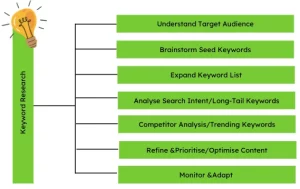
- Understand Your Target Audience: Start by deeply understanding your target audience, their preferences, and their search behavior. Consider their demographics, interests, and specific needs related to food products.
- Brainstorm Seed Keywords: Begin with a list of general keywords related to your food products. These are known as seed keywords and can be broad terms like “healthy snacks” or “organic beverages.”
- Expand Your Keyword List: Utilize keyword research tools, such as Google Keyword Planner, SEMrush, or Ahrefs, to expand your list of potential keywords. These tools provide insights into search volume, competition, and related keywords.
- Analyze Search Intent: Consider the search intent behind each keyword. Are users seeking information, looking to make a purchase, or searching for recipes? Understanding search intent helps you align your content with user expectations.
- Long-Tail Keywords: Incorporate long-tail keywords into your strategy. These are more specific phrases that have lower search volume but often indicate higher user intent and conversion potential. For example, “gluten-free snacks for kids.”
- Competitor Analysis: Analyze the keywords your competitors are targeting. Identify gaps in their strategy and find opportunities to differentiate your brand by targeting unique keywords or offering more specialized products.
- Consider Seasonal and Trending Keywords: Pay attention to seasonal trends and food-related events that can impact search behavior. Incorporate relevant seasonal and trending keywords into your content and promotions.
- Refine and Prioritize: Evaluate the potential of each keyword based on search volume, competition, relevance, and your business goals. Prioritize keywords that have a good balance of search volume and attainability.
- Optimize Your Content: Incorporate targeted keywords naturally into your website content, including product descriptions, blog posts, and category pages. Ensure that the content provides value to users and aligns with their search intent.
- Monitor and Adapt: Regularly review and refine your keyword strategy based on performance metrics, user feedback, and changes in search trends. Stay agile and adapt your approach to ensure continued relevance and effectiveness.
Some of the tools that can be used for keyword research are:
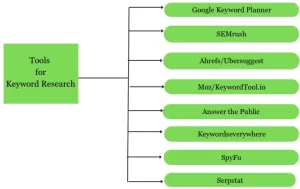
- Google Keyword Planner: This free tool by Google provides keyword ideas, search volume data, and competition insights based on actual Google search data.
- SEMrush: A comprehensive SEO tool that offers keyword research capabilities, competitor analysis, search volume data, and related keyword suggestions.
- Ahrefs: An all-in-one SEO tool that provides keyword research features, backlink analysis, competitor research, and search volume data.
- Moz Keyword Explorer: Moz offers a keyword research tool that provides keyword suggestions, search volume data, keyword difficulty, and SERP analysis.
- KeywordTool.io: This tool generates keyword ideas from Google Autocomplete and provides insights on search volume, trends, and related keywords.
- Ubersuggest: Ubersuggest offers keyword suggestions, search volume data, and competitive insights for organic and paid searches.
- Answer the Public: This tool generates keyword ideas in question and preposition formats, providing insights into the types of queries users search for.
- Keywordseverywhere: A browser extension that displays search volume, CPC (cost per click), and competition data directly on search engine results pages.
- SpyFu: This tool allows you to research competitor keywords, analyze their rankings, and gain insights into their organic and paid search strategies.
- Serpstat: Serpstat offers keyword research features, competitor analysis, search volume data, and keyword difficulty metrics.
On-Page SEO Strategies for Food Product Companies
On-page SEO strategies focus on optimizing various elements of your website to improve its visibility and relevance to search engines.
Implementing these strategies can enhance your website’s chances of ranking higher in search results for food-related queries.
Here are critical on-page SEO strategies for food product companies:
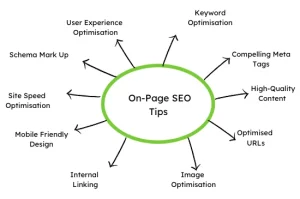
- Keyword Optimization: Incorporate relevant keywords naturally into your website’s meta titles, meta descriptions, headings, and content. Focus on high-value keywords that align with the search intent of your target audience.
- Compelling Meta Tags: Craft persuasive and keyword-rich meta titles and meta descriptions that entice users to click on your website in search results. Use clear and concise language while highlighting the unique selling points of your food products.
- High-Quality Content: Create informative, engaging, and unique content that provides value to your audience. Optimize your product descriptions, blog posts, and landing pages with targeted keywords while ensuring the content is well-written and user-friendly.
- Optimized URLs: Use descriptive and keyword-rich URLs that accurately reflect the content of your web pages. Avoid lengthy URLs and include relevant keywords to enhance search engine understanding and user experience.
- Image Optimization: Optimize your product images using descriptive filenames and adding alt tags with relevant keywords. This improves accessibility and allows search engines to understand and rank your images.
- Internal Linking: Incorporate internal links within your website to create a logical site structure and improve navigation. Link relevant pages and products together to help search engines effectively discover and index your content.
- Mobile-Friendly Design: Ensure your website is mobile-responsive and provides a seamless experience across different devices. Mobile optimization is crucial for both user experience and search engine rankings.
- Site Speed Optimization: Optimize your website’s loading speed by compressing images, minifying CSS and JavaScript files, and utilizing caching techniques. A fast-loading website enhances user experience and can positively impact search rankings.
- Schema Markup: Implement schema markup to provide structured data about your food products, such as ingredients, nutrition information, and reviews. This helps search engines understand and display your content more effectively.
- User Experience Optimization: Prioritize user experience by organizing your website’s layout, improving readability, and ensuring intuitive navigation. User-friendly websites have higher engagement, lower bounce rates, and better search rankings.
Technical SEO for Food Product Companies
Technical SEO refers to the optimization of technical aspects of a website to improve its visibility and performance in search engine rankings. Implementing technical SEO strategies is crucial for food product companies to ensure their websites are easily accessible, crawlable, and indexable by search engines.
Here are key technical SEO strategies for food product companies:
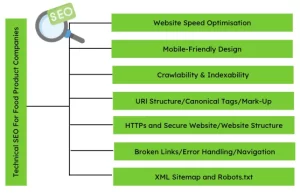
- Website Speed Optimization: Improve your website’s loading speed by optimizing image sizes, enabling browser caching, minimizing CSS and JavaScript files, and utilizing content delivery networks (CDNs). A fast-loading website enhances user experience and can positively impact search rankings.
- Mobile-Friendly Design: Ensure your website is mobile-responsive, providing a seamless experience across different devices. Mobile optimization is crucial, as search engines prioritize mobile-friendly websites and mobile usage continues to rise.
- Crawlability and Indexability: Ensure search engines can easily crawl and index your website’s pages. Create a sitemap.xml file and submit it to search engines to help them discover and understand your website’s structure.
- URL Structure: Use clean and descriptive URLs that include relevant keywords and reflect the content of your web pages. Avoid using long, complex URLs that are difficult for both users and search engines to understand.
- Canonical Tags: Implement canonical tags to specify the preferred duplicate or similar content version. This helps prevent duplicate content issues and consolidates the SEO value of your pages.
- Structured Data Markup: Implement schema markup to provide structured data about your food products, such as ingredients, nutrition information, and reviews. This helps search engines understand and display your content more effectively.
- HTTPS and Secure Website: Ensure your website is secured with an SSL certificate and is accessible over HTTPS. A secure website improves user trust and is a ranking factor for search engines.
- Website Structure and Navigation: Organize your website’s structure and navigation in a logical and user-friendly manner. Use internal linking to connect relevant pages and help search engines understand the relationships between your content.
- Broken Links and Error Handling: Regularly check for broken links and fix them promptly. Implement proper error handling, such as 301 redirects for broken or outdated pages, to ensure a smooth user experience and maintain SEO value.
- XML Sitemap and Robots.txt: Create and maintain an XML sitemap to help search engines crawl and index your website effectively. Use a robots.txt file to guide search engine crawlers and control which pages should be excluded from indexing.
Building Authority and Backlinks
Building authority and acquiring high-quality backlinks are essential for food production companies to improve their search engine rankings and increase their online visibility. Backlinks from reputable websites signal to search engines that your website is trustworthy and relevant. Here are effective strategies for building authority and acquiring backlinks:

- Create Compelling and Shareable Content: Produce high-quality content that provides value to your target audience, such as informative blog posts, recipes, cooking tips, or nutrition guides. Engaging content increases the likelihood of other websites linking to it naturally.
- Guest Blogging: Contribute guest posts to relevant and authoritative food blogs, publications, or industry websites. This allows you to showcase your expertise, reach a wider audience, and earn backlinks from authoritative sources.
- Influencer Partnerships: Collaborate with influencers or bloggers in the food industry to promote your products. Influencers can feature your products in their content, share recipes using your ingredients, or write reviews, generating valuable backlinks and brand exposure.
- Supplier and Partner Links: Seek opportunities to get backlinks from your suppliers, distributors, or business partners. They may mention your brand or products on their websites, providing relevant backlinks to your website.
- Sponsorships and Events: Sponsor or participate in food-related events, festivals, or charitable initiatives. These opportunities often lead to mentions and backlinks from event websites or media coverage.
- Online Directories and Listings: Submit your business to relevant online directories and listings specific to the food industry. These directories provide opportunities for backlinks and increase your visibility in local search results.
- Testimonials and Reviews: Provide testimonials or reviews for products or services you use within the food industry. This can lead to backlinks when your testimonials are featured on their websites.
- Press Releases and Media Coverage: Publish newsworthy press releases and reach out to local media outlets, industry publications, or online news platforms. Getting your story picked up can result in valuable backlinks and increased brand visibility.
- Social Media Engagement: Actively engage with your audience on social media platforms. Encourage users to share their experiences with your products, and when influential users mention your brand, it can generate backlinks and brand recognition.
- Monitor and Outreach: Regularly monitor mentions of your brand or products online. Reach out to website owners or bloggers who mention your brand without linking and kindly request them to include a backlink.
Local SEO for Food Product Companies
Local SEO is vital for food product companies aiming to attract customers within their specific geographical areas. Optimizing for local search can help increase visibility in local search results and drive targeted traffic to physical stores or online platforms.
Here are key strategies for implementing effective local SEO for food product companies:
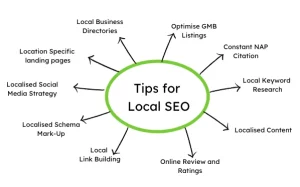
- Optimize Google My Business (GMB) Listing: Create and optimize your GMB listing with accurate and up-to-date information, including your business name, address, phone number (NAP), website URL, and business hours. Verify your listing and select relevant categories to appear in local search results.
- Consistent NAP Citations: Ensure your business NAP is consistent across all online directories, local listings, and social media profiles. Consistency builds trust and helps search engines associate your business information with specific locations.
- Local Keyword Research: Conduct keyword research specific to your local area. Include location-based keywords in your website content, meta tags, and headings to improve visibility in local search results.
- Localized Content: Create location-specific content, such as blog posts, articles, or guides, that cater to the interests and needs of your local audience. This can include highlighting local ingredients, featuring local recipes, or sharing stories about your involvement in the local community.
- Online Reviews and Ratings: Encourage customers to leave reviews and ratings on platforms like Google, Yelp, and industry-specific review sites. Positive reviews enhance your online reputation and influence local search rankings.
- Local Link Building: Seek opportunities for local link building by reaching out to local businesses, food bloggers, or influencers. Collaborate on content or partnerships that generate backlinks and promote your brand within the local community.
- Localized Schema Markup: Implement localized schema markup on your website to provide search engines with specific information about your business, such as an address, phone number, business hours, and customer reviews.
- Localized Social Media Strategy: Engage with your local audience on social media platforms. Share local-centric content, participate in local events, and collaborate with local influencers to increase brand visibility within your target location.
- Location-Specific Landing Pages: Create dedicated landing pages for each location you serve. Optimize these pages with localized keywords, unique content, and testimonials or customer reviews in those areas.
- Local Business Directories: Submit your business information to relevant local directories, such as Yelp, TripAdvisor, and Yellow Pages. Ensure your NAP is consistent and complete in these directories to improve your local search presence.
Measuring and Analysing SEO Performance
Measuring and analyzing your SEO efforts’ performance is crucial to understanding your strategies’ effectiveness and making data-driven optimizations.
Here are key steps for measuring and analyzing SEO performance:
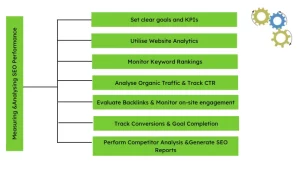
- Set Clear Goals and Key Performance Indicators (KPIs): Define your SEO goals, improving organic traffic, increasing keyword rankings, or driving conversions. To track your progress, identify relevant KPIs, such as organic traffic, keyword rankings, click-through rates (CTRs), and conversion rates.
- Utilize Website Analytics: Set up and integrate a robust website analytics platform like Google Analytics to track and measure key SEO metrics. Monitor organic traffic, user behavior, landing page performance, and conversions to gain insights into your website’s SEO performance.
- Monitor Keyword Rankings: Track the rankings of your target keywords using SEO tools like SEMrush or Ahrefs. Regularly analyze keyword rankings to identify trends, opportunities, and areas for improvement.
- Analyze Organic Traffic: Dive deeper into your website’s organic traffic data to understand which pages and keywords drive the most traffic. Analyze user behavior metrics like bounce rate, time on page, and pages per session to assess the quality of organic traffic.
- Track Click-Through Rates (CTRs): Monitor the CTRs of your website’s search engine results page (SERP) listings. Analyze the performance of meta titles and meta descriptions to optimize them for higher CTRs.
- Evaluate Backlink Profile: Assess the quantity and quality of backlinks to your website using tools like Ahrefs or Moz. Monitor the growth of your backlink profile and identify opportunities to acquire high-quality backlinks.
- Monitor On-Site Engagement: Analyze on-site engagement metrics, such as time on page, scroll depth, and conversion rates. These metrics provide insights into the effectiveness of your website’s content and user experience.
- Track Conversions and Goal Completion: Set up conversion tracking to measure the impact of SEO on goal completions, such as form submissions, purchases, or newsletter sign-ups. Identify the top-performing landing pages and keywords that drive conversions.
- Perform Competitor Analysis: Analyze the SEO performance of your competitors to identify areas where you can improve. Evaluate their keyword rankings, backlink profiles, content strategies, and on-page optimizations to gain insights and adjust your strategy accordingly.
- Generate SEO Reports: Regularly generate comprehensive SEO reports that encompass all relevant metrics and insights. Present the data in a clear and visually appealing format, highlighting the essential findings and recommendations for improvement.
Future SEO Trends for Food Product Company
SEO is constantly evolving, and food product companies must stay ahead of the curve to maintain online visibility and attract relevant traffic.
Here are some future SEO trends that food product companies should consider:
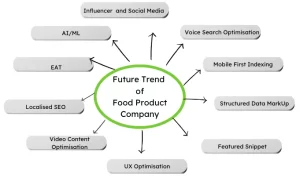
- Voice Search Optimization: With the growing popularity of voice-enabled devices and virtual assistants, optimizing for voice search is becoming crucial. Food product companies should focus on long-tail keywords and conversational phrases that align with how people speak when using voice search.
- Mobile-First Indexing: Mobile usage continues to rise, and search engines prioritize mobile-friendly websites. Food product companies must ensure their websites are responsive, load quickly, and provide a seamless user experience across all mobile devices.
- Structured Data Markup: Implementing structured data markup, such as schema.org, helps search engines understand and display your content more effectively. Food product companies can leverage structured data to highlight product information, recipes, nutrition details, and reviews, enhancing visibility in search results.
- Featured Snippets and Position Zero: Featured snippets provide valuable visibility and can significantly increase organic traffic. Optimizing content to target featured snippets and aiming for position zero in search results should be a priority for food product companies.
- User Experience (UX) Optimization: User experience is crucial for SEO success. Food product companies should focus on providing a user-friendly website with straightforward navigation, fast loading times, easy-to-read content, and intuitive design to enhance user engagement and satisfaction.
- Video Content Optimization: Video consumption is growing rapidly, and optimizing video content can improve visibility in search results. Food product companies should optimize video titles, descriptions, and tags with relevant keywords and provide transcripts or captions to make videos more accessible.
- Localized SEO: As local search becomes increasingly essential, optimizing for local SEO is crucial for food product companies with physical stores or local markets. This includes creating location-specific landing pages, optimizing for local keywords, and managing online reviews and ratings.
- E-A-T (Expertise, Authoritativeness, Trustworthiness): Establishing expertise, authoritativeness, and trustworthiness is crucial for SEO. Food product companies should create high-quality, authoritative content, obtain backlinks from reputable sources, and demonstrate industry expertise to build credibility.
- Artificial Intelligence (AI) and Machine Learning: Search engines increasingly utilize AI and machine learning algorithms to deliver more relevant search results. Food product companies should understand user intent, optimize for semantic search, and create content that aligns with searcher preferences and behavior.
- Influencer and Social Media SEO: Collaborating with influencers and leveraging social media platforms can significantly impact SEO. Food product companies should build relationships with influencers who align with their brand, encourage social sharing of their content, and optimize social media profiles for relevant keywords.
Conclusion
Effective SEO strategies are vital for food product companies to thrive in the digital landscape. By conducting keyword research, optimizing on-page elements, focusing on technical SEO, building authority through backlinks, leveraging local SEO, and staying ahead of future trends, companies can enhance their online visibility and attract targeted traffic.
To further optimise your SEO efforts and drive success in the food industry, connect with our experts at hello[at]noboruworld.com. Take advantage of the opportunity to take your food product company to new heights with a comprehensive SEO approach.
FAQ
How can SEO benefit food product companies?
SEO can benefit food product companies by improving their online visibility, increasing organic website traffic, attracting targeted leads, and enhancing brand awareness. It helps potential customers discover their products through search engines and promotes engagement and conversions.
What are some key SEO strategies for food product companies?
Some key SEO strategies for food product companies include conducting keyword research specific to their products, optimizing product pages with relevant keywords, creating high-quality and unique product descriptions, utilizing schema markup for rich snippets, optimizing images with alt tags, and earning backlinks from relevant food and recipe websites.
How can food product companies optimize their website for local search?
Food product companies can optimize their website for local search by including their location and relevant keywords in title tags, meta descriptions, and page content. They can also create a dedicated “Store Locator” or “Where to Buy” page, optimize their Google My Business profile, and encourage customers to leave reviews on platforms like Google Maps and Yelp.
Is content marketing important for SEO in the food product industry?
Content marketing is important for SEO in the food product industry. Creating and promoting valuable and informative content related to food, recipes, nutrition, and cooking tips can attract organic traffic, engage customers, and build authority. Blogging, recipe sharing, and video content can all contribute to improved search engine rankings and customer loyalty.
How can food product companies leverage social media for SEO?
Food product companies can leverage social media for SEO by promoting their products, sharing valuable content, and engaging with their audience. Social media signals, such as likes, shares, and comments, can indirectly impact search rankings. Additionally, social media profiles often appear in search results, providing an opportunity for increased brand visibility and website traffic.



